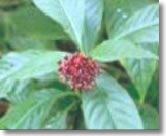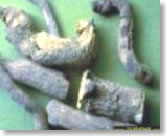
SARPAGANDHA
Botanical Name: Rauwalfia serpentine ( Apocyanaceae)
English Name: Serpentina root
Hindi Name: Chota chand

Introduction: Sarpagandha is considered to be one of the later entireis into Indian medicine. But it is the contribution of ancient medicine towards the management of hypertension. Some consider that Nakuli of ancient texts is Sarpagandha. But Bengali kavirajas used this plant in the management of hypertension. On the basis of Gananathsen’s clinical report in a local health magazine from Calcutta, Dr. Rustumjal Vakil published a paper at London and provided the world the first therapeutic agent for hypertension. Since then it is in vogue for BP management. In ancient medicine it is also used for the treatment of epilepsy, insomnia, scizopherina and other CNS disorders.
Distribution: It is glabrous under-shrub which grows in waste places and shady forests in India. It is now considered red listed and widely cultivated at many parts of India.
Chemical Constituents: Ajmalicidine, ajmalicine, reserpine, sargagine, serpentine, serpentinine, ajamline, rauwolfinine, serpinine etc.
Properties: Bitter, hot, tranquilizing, anti-hypertensive etc.
Indications: Hypertension, insomnia, epilepsy, giddiness etc.
Dose: Powder 3-6g in insomnia, epilepsy & schizophrenia: 1-2g in hypertension.
Therapeutic Uses:
- Erruptive fevers: Sarpagandha is administered with warm water.
- Snake Bite: Root powder is given orally as well as root paste is applied locally.
Scientific Studies:
Anti-hypertensive activity: The activity is extensively studied and the active ingredient reserpine is widely used as drug for the management of high BP.
Cultivation Technology: The plant requires slightly acidic to neutral soils and rich in organic matter. It prefers loam to sandy-loam soils and partial shade is best suited for its cultivation. It can be propagated by seed, stem and root cuttings. Soaking of seed for atleast 24 hours in water/gomutra enhances its germination. Seeds are sown in the month or May-June in nursery beds and 15-20 cm long seedlings are transplanted to fields preferably on ridges at the spacing of 30x30 cm or 45x30 cm in July-August. Irrigate the field immediately after transplanting and alter as and when required.
Harvesting: Seeds can be collected in the month of October-November. Roots are collected after 2-3 years of plantation, when plants shed their leaves in winter.







